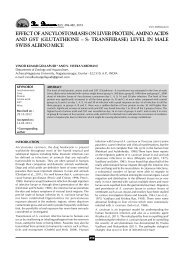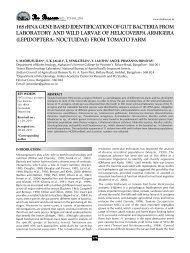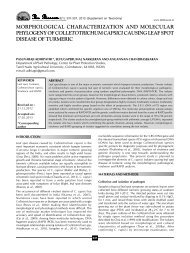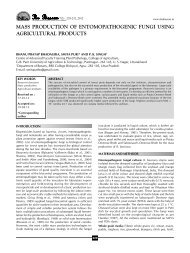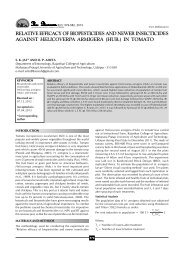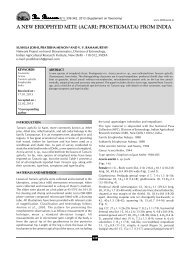Genetic diversity analysis of acid lime (Citrus ... - THE BIOSCAN
Genetic diversity analysis of acid lime (Citrus ... - THE BIOSCAN
Genetic diversity analysis of acid lime (Citrus ... - THE BIOSCAN
You also want an ePaper? Increase the reach of your titles
YUMPU automatically turns print PDFs into web optimized ePapers that Google loves.
NSave Nature to Survive8(2): 481-484, 2013www.thebioscan.inGENETIC DIVERSITY ANALYSIS OF ACID LIME (CITRUSAURANTIFOLIA SWINGLE) CULTIVARSM. KUMAR*, S. PARTHIBAN, D. SARALADEVI AND V. PONNUSWAMIHorticultural College and Research Institute, Periyakulam - 625 604, Tamil Nadu, INDIAe-mail: kumshorts@gmail.comKEY WORDSAcid <strong>lime</strong>Cultivars<strong>Genetic</strong> <strong>diversity</strong>RAPDReceived on :31.12.2012Accepted on :07.03.2013*CorrespondingauthorABSTRACTAcid <strong>lime</strong> (<strong>Citrus</strong> aurantifolia Swingle) is an important commercial fruit crop, cultivated in our country. Highvariation <strong>of</strong> <strong>acid</strong> <strong>lime</strong> fruits are observed in existing varieties due to crossing within the other <strong>acid</strong> <strong>lime</strong> accessions.Determination <strong>of</strong> genetic variation is important to the plant breeders for development <strong>of</strong> high yielding variety.Therefore, an attempt has been made to study the genetic <strong>diversity</strong> <strong>of</strong> 6 <strong>acid</strong> <strong>lime</strong> varieties, maintained in ourorchard. Ten Random amplified polymorphic DNA (RAPD) primers were used to assess the genetic <strong>diversity</strong> <strong>of</strong><strong>acid</strong> <strong>lime</strong>. The average genetic similarity level among the 6 varieties was 60.5%, separated four major clustergroups. Total <strong>of</strong> 76 alleles <strong>of</strong> which 35 were polymorphic detected by ten primers RAPD markers. The Jaccardcoefficient was used to calculate the genetic similarity. UPGMA was used to generate the dendrogram whichclearly showed that the six <strong>acid</strong> <strong>lime</strong> varieties formed four clusters. Among the different clusters, the cluster sizevaried from 2 (cluster I and III) to 1 (cluster II, IV). The cluster I consisted <strong>of</strong> PKM -1 and Vikram. The cluster IIconsisted <strong>of</strong> Saisarbathi. The cluster III consisted <strong>of</strong> Pramalini and Tenali. The cluster IV consisted <strong>of</strong> Kasipentla.Among the cultivars, Pramalini and Tenali showed nearly 92% similarity followed by PKM-1 and Vikram whichshowed nearly 80% similarity. Kasipentala showed nearly 58% similarity, and Saisarbathi nearly 46% similarity.RAPD are highly polymorphic and more informative for the assessment <strong>of</strong> genetic <strong>diversity</strong> <strong>of</strong> <strong>acid</strong> <strong>lime</strong> varieties.INTRODUCTION<strong>Citrus</strong> in India is grown in 0.48 million ha area with a totalproduction <strong>of</strong> 4.27 million tonnes. The most importantcommercial citrus groups or cultivars in India are the mandarin(<strong>Citrus</strong> reticulata Blanco) followed by sweet orange (<strong>Citrus</strong>sinensis Osbeck) and <strong>acid</strong> <strong>lime</strong> (<strong>Citrus</strong> aurintifolia Swingle)sharing 41, 23 and 23% <strong>of</strong> the respectively. India is the largestproducer <strong>of</strong> <strong>acid</strong> <strong>lime</strong> in the world (Chadha, 2002). It isgenerally grown under both tropical and subtropical climaticconditions in the plains and up to 1200 MSL. In India, it iscommercially cultivated in the states <strong>of</strong> Maharastra, AndraPradesh, Karnataka, Tamil Nadu, Gujarat and Bihar. In TamilNadu, it is widely cultivated under rainfed and irrigatedconditions in the districts <strong>of</strong> Dindigul, Trichy, Tirunelveli,Virudhunagar, Ramanathapuram, Madurai, Theni etc., in anarea about 1,060 ha with a production <strong>of</strong> about 4,400 tonnesper annum (Anon., 2003).<strong>Genetic</strong> variation and genetic relationship among genotypesis an important consideration for classification, utilization <strong>of</strong>germplasm resources and breeding. Without determining the<strong>diversity</strong> reliably, it would not be possible to identify molecularmarkers or qualitative trait associations. Moreover the viabilityand purity <strong>of</strong> rootstocks can be analyzed through the utilization<strong>of</strong> fingerprints based on molecular markers. This process canincrease both quantity and quality <strong>of</strong> fruit production. <strong>Citrus</strong>is an economically important fruit crop, ranking almost ashigh as in world production and trade. The phylogeny andtaxonomy <strong>of</strong> citrus fruit are complex, confusing andcontroversial due to the genetic heterogeneity <strong>of</strong> the genus, aswell as its polyembryonic nature and the long generation timeneeded to carry out selection and recombination (Swingle,1946; Nicolosi et al., 2000). Therefore, <strong>analysis</strong> <strong>of</strong> the genetic<strong>diversity</strong> <strong>of</strong> citrus fruit is crucial. To this end, DNA markers arebeing widely used in studying polymorphism between speciesor in populations. The application largely depends on thetype <strong>of</strong> markers employed, distribution <strong>of</strong> markers in thegenome, type <strong>of</strong> loci they amplify, level <strong>of</strong> polymorphism andreproducibility <strong>of</strong> products (Virk et al., 2001; Fernandez et al.,2002). Techniques using Random Amplified PolymorphicDNA (RAPD) markers are simple, fast, and sensitive. Theyrequire no prior knowledge <strong>of</strong> the DNA sequence and canamplify a large number <strong>of</strong> DNA fragments for reaction. Theintroduction <strong>of</strong> DNA markers based on the polymerase chainreaction (PCR) technology has led to the development <strong>of</strong>several novel genetic assays that can be used for manypurposes in plant genetic <strong>analysis</strong> such as cultivar identificationand gene mapping. RAPD markers that result from the PCRamplification <strong>of</strong> genomic DNA fragments using shortoligonucleotide (usually 10-mers) <strong>of</strong> arbitrary sequence asprimers (William et al., 1990) provide a fast and easy approachfor taxonomic classification and cultivar-typing <strong>of</strong> fruit trees.In citrus, RAPD markers have been used for genetic <strong>diversity</strong><strong>analysis</strong> (Abkenar and Ishhiki, 2003; Mariniello et al., 2004;Campos et al., 2005; Novelli et al., 2006; Shaaban et al.,2006; Shahsavar et al., 2007; Hvarleva et al., 2008), chimeras(Sugawara et al., 2002) and phylogenetic <strong>analysis</strong> (Nicolosi etal., 2000). DNA fingerprinting using PCR-based markers isvery important for breeding and taxonomy <strong>of</strong> citrus. No DNAbasedmarkers approach to the study <strong>of</strong> citrus has beenattempted even with a large area under cultivation in India. Inthis study we used RAPD markers to characterize the <strong>acid</strong>481
M. KUMAR et al.,<strong>lime</strong> genotypes. The objectives <strong>of</strong> the study were to achieve abetter understanding <strong>of</strong> genetic variation and to investigatetheir inter-relationship. In India collection and conservation<strong>of</strong> citrus species/ types started long back in the mid <strong>of</strong> 19 thcentury. During the past, collection and conservation wereprimarily made for the quality <strong>of</strong> fruits. The current researchefforts are addressed to collection <strong>of</strong> gene pool with distinctdesirable traits, which can be utilized for improvement <strong>of</strong>cultivars. The great genetic <strong>diversity</strong> is under serious threat <strong>of</strong>rapid extinction or depletion <strong>of</strong> the germplasm mainly due topopulation pressure and farmers preference (Singh. 2004).Thepresent study was undertaken to evaluate certain importantcultivars <strong>of</strong> <strong>acid</strong> <strong>lime</strong> (<strong>Citrus</strong> aurantifolia Swingle).MATERIALS AND MATHODSPlant materialA total <strong>of</strong> 6 <strong>acid</strong> <strong>lime</strong> genotypes used in this study were collectedfrom the citrus orchard <strong>of</strong> Horticultural college and ResearchInstitute, Periyakulam, Tamilnadu, India.DNA isolationTotal genomic DNA was isolated from fully expanded leavesusing the CTAB (hexadecyltrimethylammonium-bromide)method (Murray and Thompson, 1980) with few modifications.Briefly, 2g <strong>of</strong> leaves were ground in liquid nitrogen to a finepowder. The powder was added to 6 mL <strong>of</strong> extraction buffer(100 mM Tris–HCl pH 8.0, 20mM EDTA, 1.4 M NaCl, 2%(wv-1) CTAB, 2–mercaptoethanol 2% and 1% (wv-1) PVP andincubated at 65ºC for 30 min. The DNA was extracted withchlor<strong>of</strong>orm – octanol (24: 1). The DNA was washed with 70%ethanol and dissolved in 100-400µL <strong>of</strong> TE (10mM Tris–HClpH 8.0, 1 mM EDTA and 0.2mg mL-1 RNase). The DNAconcentration was determined spectrophotometrically at260nm. Stock DNA samples were stored at –20ºC and dilutedto 20ng uL-1 when in use.PCR procedureThe RAPD primers were purchased from OperonTechnologies Alameda, CA, USA. A total <strong>of</strong> 40 decameroligonucleotides <strong>of</strong> arbitrary sequence were tested for PCRamplification. The basic protocol reported by William et al.(1990) for PCR was performed in a total volume <strong>of</strong> 12.5µL,containing 25ng <strong>of</strong> template DNA, 0.4 µM <strong>of</strong> single primer,0.6 U Taq DNA polymerase (Bangalore Genei, India), 0.20µM<strong>of</strong> each dNTP, 1.5mM MgCl2, 10 mM Tris–HCl, and 50 mMKCl. DNA amplification was carried out in a PTC- 10096VThermocycler (MJ Research, Inc, USA) and the thermal cyclerconditions for PCR reactions were an initial denaturation cycle<strong>of</strong> 1 min and 30 s at 94ºC was followed by 45 cycles comprising1 min at 94ºC, 1 min at 36ºC and 2 min at 72 ºC. An additionalcycle <strong>of</strong> 7 min at 72ºC was used for final extension.Amplification products were separated by electrophoresis (8.3V cm-1) in 1.5% agarose gels and stained in ethidium bromide.A photographic record was taken under UV illumination.Data <strong>analysis</strong>Only clear and repeatable amplification products were scoredas 1 for present bands and 0 for absent ones. The specificbands useful for identifying species and cultivars were namedwith a primer number followed by the approximate size <strong>of</strong> theamplified fragment in base pairs. Polymorphism was calculatedbased on the presence or absence <strong>of</strong> bands. The 0 or 1 datamatrix was created and used to calculate the genetic distanceand similarity using “Simqual” a subprogram <strong>of</strong> the NTSYS-PCprogram (numerical taxonomy and multivariate <strong>analysis</strong> systemprogram) (Rohlf, 1993). The genetic associations betweenaccessions were evaluated by calculating the Jaccard’s similaritycoefficient for pair wise comparisons based on the proportions<strong>of</strong> shared bands produced by the primers (Jaccard, 1908).The dendrogram was constructed by using a distance matrixusing the unweighed pairgroup method with arithmeticaverage (UPGMA) sub-program <strong>of</strong> NTSYS-PC.RAPD - PCR <strong>analysis</strong>DNA from six <strong>acid</strong> <strong>lime</strong> cultivars was amplified using a set <strong>of</strong>10 RAPD primer pairs OPA-02, OPG-02, OPG-05, OPO-12,OPA-07, OPB-05, OPA-09, OPH-15, OPA-17 and OPH-20.The RAPD primers which are located near to were selected inthe present study. Those RAPD primers which amplified thepresent set <strong>of</strong> germplasm were used for <strong>diversity</strong> <strong>analysis</strong> afteroptimization <strong>of</strong> PCR conditions. Finally 10 primers whichshowed good amplification were selected.RESULTS AND DISCUSSIONCluster based on dendrogramThe similarity values obtained for each pair wise comparison<strong>of</strong> RAPD markers among the six <strong>acid</strong> <strong>lime</strong> cultivars were usedto construct dendrogram based on Jaccard’s coefficient andthe results are presented (Fig. 1). Total <strong>of</strong> 76 alleles <strong>of</strong> which35 were polymorphic detected by ten RAPD markers. The six<strong>acid</strong> <strong>lime</strong> cultivars formed 4 clusters at nearly 60.5% similaritylevels. Among the different clusters, the cluster size variedfrom 2 (cluster I and III) to 1 (cluster II, IV). The cluster I consisted<strong>of</strong> PKM -1 and Vikram. The cluster II consisted <strong>of</strong> Saisarbathi.The cluster III consists <strong>of</strong> Pramalini and Tenali. The cluster IVconsisted <strong>of</strong> Kasipentla. Among the cultivars, Pramalini andTenali showed nearly 92% similarity followed by PKM-1 andVikram which showed nearly 80% similarity. Kasipentalashowed nearly 58% similarity, and Saisarbathi nearly 46%similarity. On drawing a vertical line in the dendrogram (Fig.1) along the point corresponding to a distance <strong>of</strong> 0.92 all thesix <strong>acid</strong> <strong>lime</strong> cultivars got divided into 4 clusters. All thecultivars <strong>of</strong> distance 0.32 came under single cluster. At adistance <strong>of</strong> 0.90 all the cultivars formed single stand six clusters.At a distance <strong>of</strong> 0.92 Tenali and Pramalini formed singlecluster, Whereas at a distance <strong>of</strong> 0.82 single cluster was formedby PKM – 1 and Vikram. At a distance <strong>of</strong> 0. 58, Pramalini,Tenali and Kasipentla came under single cluster. At a distance<strong>of</strong> 0.46 PKM – 1, Vikram and Saisarbati were found to formsingle cluster. Among the six <strong>acid</strong> <strong>lime</strong> cultivars, Saisarbatihad maximum genetic <strong>diversity</strong>.Molecular characterizationMorphological traits have been extensively used to determinethe relationship among plants and its varieties (Ortiz et al.,1998). However, morphological markers do not <strong>of</strong>ten reflectgenetic relationships because <strong>of</strong> their interaction with theenvironment epistasis and the largely unknown genetic control<strong>of</strong> the traits (Smith and Smith, 1998). In contrast, molecular482
GENETIC DIVERSITY ANALYSIS OF ACID LIME0.32 0.47 0.62 0.77 0.92CoefficientFigure 1: Dendrogram for Acid <strong>lime</strong> based on marker dataLane 1 - Ladder (100bp)Lane 2 Pkm1Lane 3 - SaisarbathiLane 4 - PramaliniLane 5 - VikramLane 6- TenaliLane 7 - KasipentlaFigure 2: RAPD marker <strong>analysis</strong> in <strong>acid</strong> <strong>lime</strong> cultivarsPKM1Lane 1 - Ladder (100bp)Lane 2 Pkm1Lane 3 - SaisarbathiLane 4 - PramaliniLane 5 - VikramLane 6- TenaliLane 7 - KasipentlaVIKRAMSAISARBATIPRAMALINITENALIKASIPENTLA1 2 3 4 5 6 7 1 2 3 4 5 6 7markers are not influenced by environment or developmentalstage <strong>of</strong> a plant making them ideal for genetic relationshipstudies. Random amplified polymorphic DNA (RAPD) is one<strong>of</strong> the widely used molecular markers for identifying varietiesat the genotypic level. It can help to overcome thecomplications arising in morpho – anatomical characterization.RAPD <strong>analysis</strong> has been successfully used to identify thegeneric <strong>diversity</strong> in a number <strong>of</strong> crop plants (Reiter et al.,1992). In the present study an attempt has been made todetermine the extent <strong>of</strong> genetic <strong>diversity</strong> in six <strong>acid</strong> <strong>lime</strong>cultivars, based on RAPD markers making use <strong>of</strong> arbitraryprimers to amplify random DNA sequences in the genome.In order to identify promising primer for identifying RAPDmarkers <strong>analysis</strong> 10 DECAMER for primers were screened.Only 10 primers out <strong>of</strong> the all primers yielded amplificationproducts. Total number <strong>of</strong> bands ranged from 1 to 6 (Fig. 2).The primers OPA-02, OPA-07 and OPA-09 yieldedpolymorphic products and others showed no sequencecomp<strong>lime</strong>ntary to this primer in the DNA. In the present studya total number <strong>of</strong> 76 bands were generated with an average <strong>of</strong>3 bands per primer with 35 were polymorphic and otherswere monomorphic. Finally, 3 primers viz., OPA-02, OPA-07,and OPA-09 for RAPD <strong>analysis</strong> were identified based on thenumber <strong>of</strong> polymorphic bands obtained. Five random primerswere identifying in 7 local citrus accessions (Shaaban et al.,2006). Studied on Brassica sp (Demeke et al., 1992) indicatedthat the minimum 17 primers were necessary to obtain a stableclassification <strong>of</strong> related species. However, (Bhat and Jarret,1995) suggested that the number <strong>of</strong> polymorphism might bemore important than the number <strong>of</strong> primers for the generation<strong>of</strong> a stable phenogram. They also suggested that the number<strong>of</strong> polymorphism required to generate a stable phenotic<strong>analysis</strong> would vary with the plant material under investigationand the sequences that are amplified.Ten promising primers used in the present study which yielded35 polymorphic scorable bands with on average <strong>of</strong> 17.5 bandsper primers. The amplification product ranged from 100 –700 bp. The number <strong>of</strong> bands resolved for amplification wasprimers dependent and varied form 2 – 6. In a similar studycarried for the assessment <strong>of</strong> genetic <strong>diversity</strong> in 57 Musagenotypes at NBPGR, New Delhi, Bhat and Jarret 1995,reported that 49 promising primers yielded 605 scorablebands with an average <strong>of</strong> 12.35 bands per primers in a similarstudy. High level <strong>of</strong> genetic <strong>diversity</strong> in <strong>acid</strong> <strong>lime</strong> varieties hasbeen reported by previous studies and composed <strong>of</strong> differentphenotype, genotype and large number <strong>of</strong> varieties. Thisvariation allows identifying the different cultivars withmolecular markers. Molecular marker may provideinformation on the history and biology <strong>of</strong> cultivars, but it doesnot necessary to reflect what may be observed inmorphological traits (Metais et al., 2000).ACKNOWLEDGEMENTI authors acknowledge the Chairman and the Director, Centrefor Plant Molecular Biology, Tamilnadu Agricultural UniversityCoimbatore, India.REFERENCESAbkenar, A. and Isshiki, S. 2003. Molecular characterization andgenetic <strong>diversity</strong> among Japanese <strong>acid</strong> citrus (<strong>Citrus</strong> spp.) based onRAPD markers. J. Horticultural Sciences and Biotechnology. 78: 553-556.Anonymous 2003. Area and production <strong>of</strong> <strong>acid</strong> <strong>lime</strong> in Tamil Nadu.Hort Stat - pp.135.Bhat, K.V. and Jarret, R. L. 1995. Random amplified polymorphicDNA and genetic <strong>diversity</strong> in Indian musa germplasm. Genet. Resour.Crop Eval. 42: 107 – 118.Campos, E. T., Espinosa, M. A. G., Warburton, M. L., Varela, A. S.and Monter, A. V. 2005. Characterization <strong>of</strong> mandarin (<strong>Citrus</strong> spp.)using morphological and AFLP markers. Interciencia. 30: 687- 693.Chadha, K. L. 2002. Hand book <strong>of</strong> Horticulture. ICAR publication,New Delhi.pp:.209.Demeke, T., Adams, R. P. and Chibbar, R. 1992. Potential taxonomicuse <strong>of</strong> random amplified polymorphic DNA (RAPD): a case study inBrassica. Theor. Appl. Genet. 84: 990 – 994.Fernandez, M. E., Figueiras, A. M. and Benito, C. 2002. The use <strong>of</strong>ISSR and RAPD markers for detecting DNA polymorphisms, genotypeidentification and genetic <strong>diversity</strong> among barley cultivars with knownorigin. Theoretical and Applied <strong>Genetic</strong>s. 104: 845-851.Hvarleva, T., Kapari-Isaia, T., Papayiannis, I., Atanassov, A.,Hadjinicoli, A. and Kyriakou, A. 2008. Characterization <strong>of</strong> <strong>Citrus</strong>Cultivars and Clones in Cyprus through Microsatellite and RAPDAnalysis. Biotechnology and Biotechnolological Equipment. 22: 787-794.Jaccard, P. 1908. Nouvelles recherches sur la distribution florale.483
M. KUMAR et al.,Bul. Soc. Vaudoise Sci. Nat. 44: 223–270.Mariniello, L., Sommella, M. G., Cozzolino, A., Di Pierro, P., Ercolini,D. and Porta, R. 2004. Identification <strong>of</strong> Campania <strong>Citrus</strong> limon L. byRandom Amplified Polymorphic DNA Markers. Food Biotechnology.18: 289-297.Metais, I., Aubry, C., Hamon, B. and Jalouzot, R. 2000. Descriptionand Analysis <strong>of</strong> <strong>Genetic</strong> Diversity between Commercial Bean Lines(Phaseolus vulgaris L.) Theoretical and Applied <strong>Genetic</strong>s. 101: No. 8,pp. 1207-1214.Murray, M. G. and Thompson, W. F. 1980. Rapid isolation <strong>of</strong> highmolecular weight plant DNA. Nucleic Acid Research. 8: 4321- 4325.Nicolosi, E., Deng, Z. N., Gentile, A. C. A., Malfa, S., Continella, G.and Tribulato, E. 2000. <strong>Citrus</strong> phylogeny and genetic origin <strong>of</strong>important species as investigated by molecular markers. TheoreticalApplied <strong>Genetic</strong>s. 100: 1155-66.Novelli, V. M., Crist<strong>of</strong>ani, M., Souza, A. A. and Machado, M. A.2006. Development and characterization <strong>of</strong> polymorphicmicrosatellite markers for the sweet orange (<strong>Citrus</strong> sinensis L. Osbeck).<strong>Genetic</strong>s and Molecular Biology. 29: 90-96.Ortiz, R., Madsen, S. and Vuylsteke, D. 1998. Classification <strong>of</strong> Africanplantain landraces and banana cultivars using a phenotypic distanceindex <strong>of</strong> quantitative descriptors. Theor. Appl. Genet. 96: 904 – 911.Rohlf, F. 1998. NTSYS-pc: Numerical Taxonomy and MultivariateAnalysis System. Version 2.2, Exeter Publications Setauket, New York.Shaaban, E. A., Abd-EL-Aal, S. KH., Zaied, N. S. and Rizkalla, A. A.2006. Assessment <strong>of</strong> <strong>Genetic</strong> Variability on Some Orange AccessionsUsing RAPD-DNA Markers. Research J. Agriculture and BiologicalSciences. 2: 564-570.Shahsavar, A. R., Izadpanah, K., Tafazoli, E. and Sayed Tabatabaei, B.E. 2007. Characterization <strong>of</strong> citrus germplasm including unknownvariants by inter-simple sequence repeat (ISSR) markers. ScientiaHorticulturae. 112: 310-314.Singh, B. D. 2004. Screening <strong>of</strong> pomegranate (Punica granatum)cultivars for arid ecosystem. Indian .J. Agrl. Sci. 74 (11): 604 – 606.Smith, J. S. C. and Smith, O. S. 1998. The description and assessment<strong>of</strong> distance between inbred lines <strong>of</strong> maize, 11. The utility <strong>of</strong>morphological, biochemical and genetic descriptors and a schemefor testing <strong>of</strong> distinctiveness between inbred lines. Maydica. 34: 151– 161Sugawara, K., Wakizuka, T., Oowada, A., Moriguchi, T. and Omura,M. 2002. Histogenic identification by RAPD <strong>analysis</strong> <strong>of</strong> leaves andfruit <strong>of</strong> newly synthesized chimeric <strong>Citrus</strong>. J. the American Society forHorticultural Science. 127: 104-107.Swingle, W. T. 1946. The botany <strong>of</strong> citrus and its wild relatives in theorange subfamily. In: Webber H.S. and D. L. Batchelor (Eds.). The<strong>Citrus</strong> Industry, Vol. 1, University <strong>of</strong> California, Berkeley. pp. 128-474.Virk, P. S., Zhu, J., Newburg, H. J., Bryan, G. J., Jeckson, M. T. andFord-Lloyd, B. V. 2001. Effectiveness <strong>of</strong> different classes <strong>of</strong> molecularmarkers for classifying and revealing variation in rice germplasm.Euphytica. 112: 275-284.William, J. G. K., Kubelik, A. R., Livak, K. J., Rafalski, J. A. andTingey, S. V. 1990. DNA polymorphism amplified by arbitrary primersare useful as genetic markers. Nucleic Acids Research. 18: 6531-6535.484



